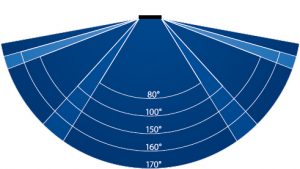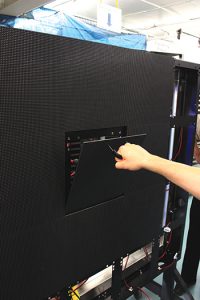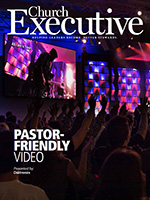
By Marty Gregor
If you’ve decided LED display walls are a good fit for your facilities, the next step is to ensure they’re properly positioned — a key component for maximum ministry benefit.
To this end, Daktronics uses two measuring approaches to determine an appropriate pixel pitch for an LED display: minimum viewing distance and smooth image distance. The graph below illustrates the viewing ranges of each display, with the bottom bar depicting the minimum viewing distance and the top bar denoting smooth image distance.
Viewing cone of an LED video display
 Particularly in the worship market, viewing angles are important — especially when the majority of the congregation isn’t directly facing the pastor and pulpit. The 170-degree horizontal viewing angles of our LED video displays allow the worshippers (no matter where they’re seated) to clearly see the video display content.
Particularly in the worship market, viewing angles are important — especially when the majority of the congregation isn’t directly facing the pastor and pulpit. The 170-degree horizontal viewing angles of our LED video displays allow the worshippers (no matter where they’re seated) to clearly see the video display content.
The viewing cones of LED video displays differ slightly, but why the difference? It’s simply a matter of geometry and how the human eye perceives light.
As the congregation moves off-center, the area of focus does not remain constant; it actually increases. It’s an effect similar to shining a flashlight on a wall: The sharper the angle between the flashlight and the wall, the greater the amount of surface area the flashlight beam will cover. As the spectator’s angle to the display increases, so does the area of focus. Increasing the area of focus results in more light reaching the eye.
Quiet operation

Smooth image distance — the point at which the video display is at its purist distance in relation to where the viewer is standing.
Efficient module and cabinet design eliminates the need for external forced ventilation. Standing next to the display with fan-less cabinets, the only thing you’ll hear is the clock ticking on the wall. Our company’s indoor displays are designed to enhance the visual appearance of the surrounding environment without impacting HVAC or the ambience with noisy operation. Without fans in the displays, there’s no worrying about routine maintenance that can be incurred with other manufacturers. This saves time, money, and increases the display’s longevity.
As a provider focused on delivering quality service for any application, we start by keeping ease of service in mind. For example, combining front and rear access with service-friendly features — such as magnetic attachment of the modules — allows extremely tight pixel pitches to have the same front access that makes maintenance convenient for technicians. This easy access enables techs to quickly replace faulty components without powering down the display.
Location — where should we put an LED display?

The location of the LED display is crucial. Typical placements of LED displays are stage right and stage left; this means the displays (usually two) are located on the right of the stage and also the left. Many times, with a larger LED display, churches will consider attaching it to a rigging system to suspend it above the stage. This application is more common in sanctuaries without wide viewing angles.
Another trend for many worship facilities is to install a display in the far back of the church, behind the congregation. This placement is mainly for the benefit of the pastor and choir, as it helps them know what the rest of the congregation is seeing, but from the front of the sanctuary. Another use is for the display of lyrics and hymns.
How an LED display enhances worship
It’s paperless. There are many benefits of an LED display, including reduced paper consumption. Cutting back on ink and paper for the weekly sermons reduces costs and saves money for the church. Displayed content can include lyrics, prayers, videos, announcements — the money-saving possibilities are numerous.
It sets the mood. When members walk into a brightly lit sanctuary on a sunny morning, vivid imagery of nature scenes can enhance their mood. Using LED displays correctly (read: accompanied by uplifting messages) creates a warm, welcoming environment for everyone.
It enables Image Magnification (IMAG). Incorporating IMAG / live video ensures everyone can see what’s going on, regardless of where they’re sitting in the sanctuary. During a service, IMAG keeps worshipers engaged with close-up shots of the choir as they sing and the pastor as he or she delivers the sermon.

No more rentals! Using permanent LED displays means churches won’t need to rent projection screens and projectors for large events. This is crucial because, in just a few years, a church will spend as much on rentals as it will to buy a permanent LED display.
Marty Gregor is a video products sales expert for Brookings, SD-based Daktronics, a leading digital display manufacturer established in 1968.



This is a well-written blog about interactive display walls, with all the vital information, and explains its benefits. It is a must-read for those who are not aware of this beautiful technology. Thanks for sharing